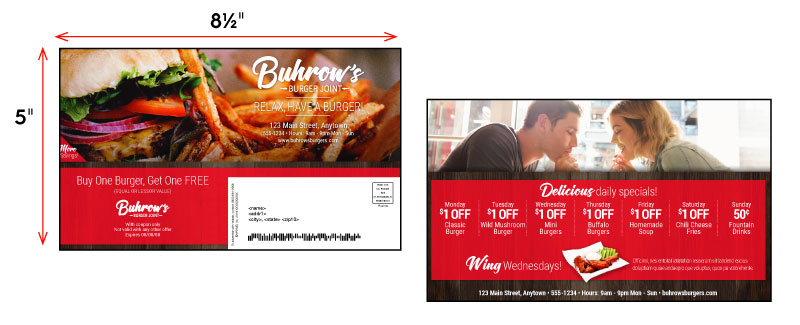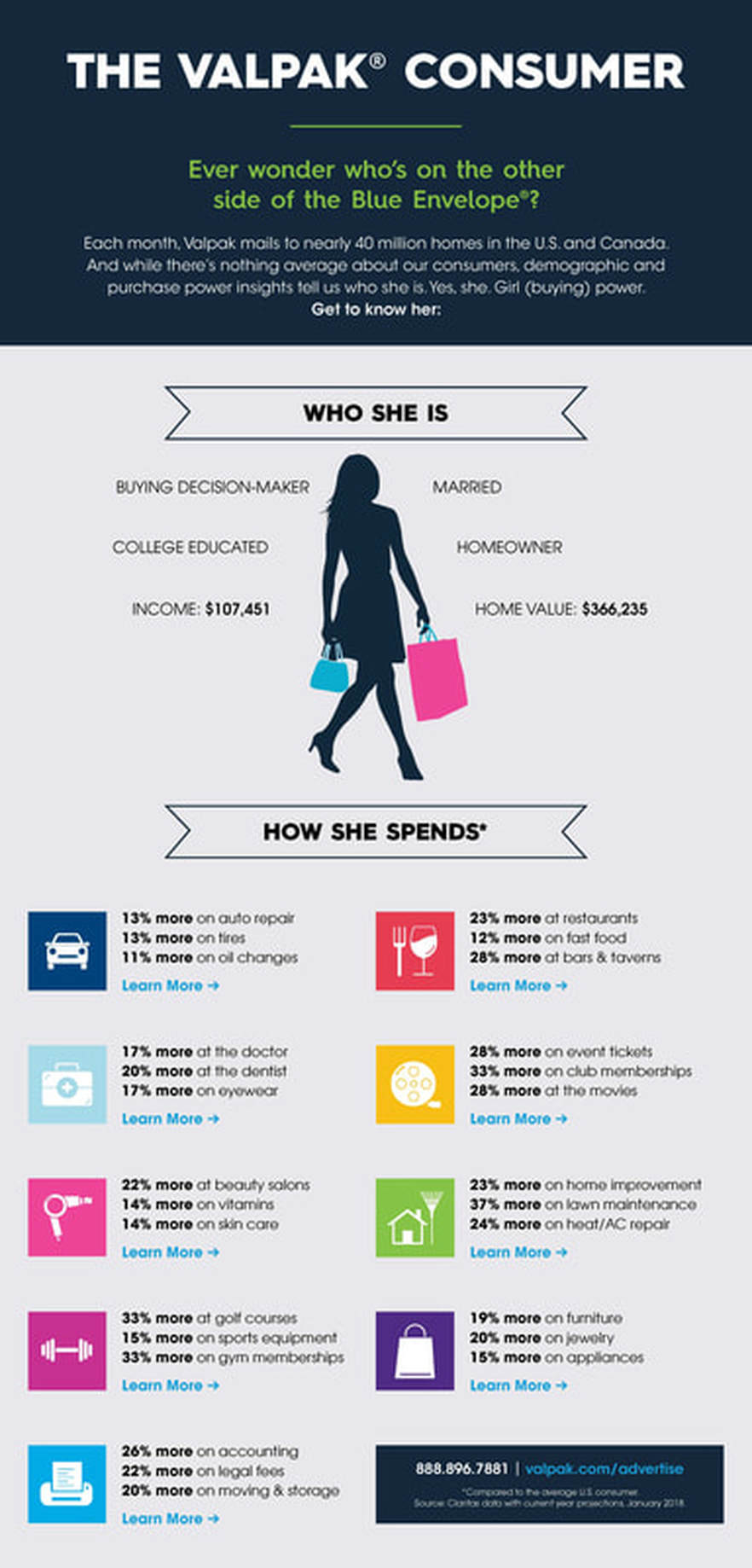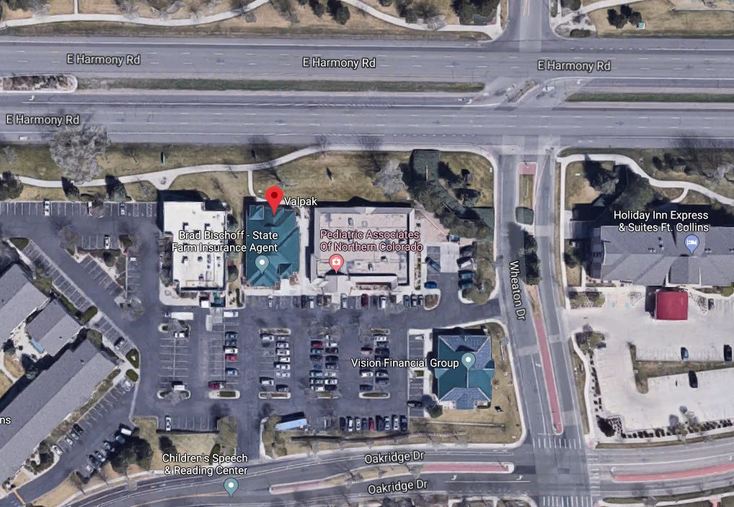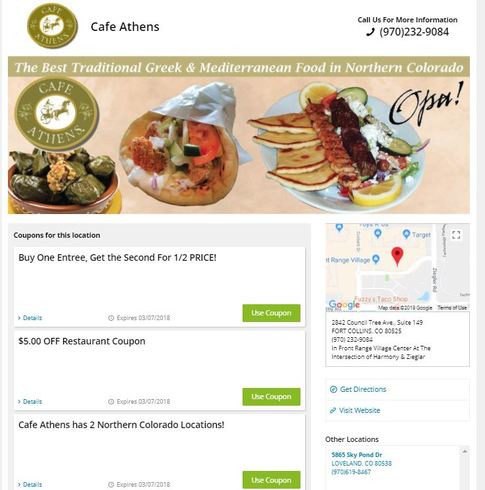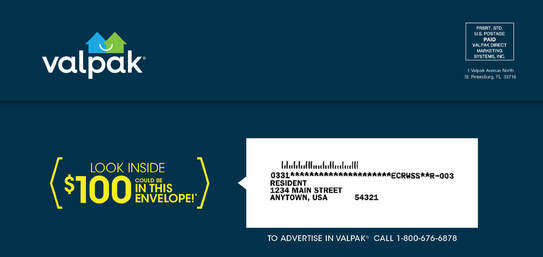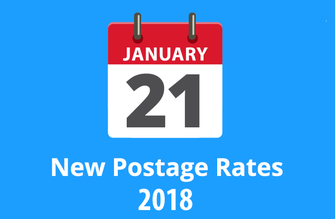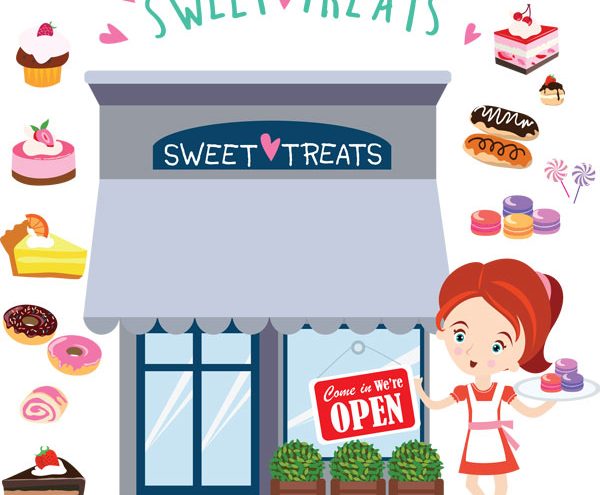|
Valpak of Northern Colorado and Southern Wyoming is testing a new product for the US Postal service called "PlusOne". It is a stand alone post card that is mailed separately from the Valpak envelope with significantly reduced postage.
Valpak has been working with the USPS for the past 2 years developing this program and it is finally being rolled out to our national network. We will start mailing this in our market next month. For more information please read this article and contact a marketing advisor today! https://www.postaltimes.com/postalnews/usps-to-launch-market-test-for-plus-one/
0 Comments
Have you ever wondered who’s on the other side of Valpak’s Blue Envelope, eagerly ripping it open and searching through/using those awesome local coupons?
We thought you might, so we went digging and unearthed some very interesting information. Then we took that information to create a visual story (infographic) about the real Valpak consumer… just for you! Whether you’re a veterinarian, pet supply store owner, pet photographer, pet sitter or pet services provider, there has never been a better, more prosperous time to be a part of the pet industry. U.S. consumers are spending more than ever on the care of their pets—what millennials refer to as “starter children.” Pets are also influencing where consumers live, work and even what kind of vehicle they buy. Direct mail marketingcan help your marketing to pet owners by reaching them in your community and turning them into “furever” customers. According to the 2017-18 APPA National Pet Owners Survey, 4 people in their 30s own dogs and over half of those also own cats. For most Americans, pets are family. In that vein, people want to give their pets the same high-quality care they would provide to their own human children. Veterinarian care expenses in 2017 hit $15.95 billion. Even though the pet industry is in the best position it’s ever been in, it doesn’t mean you don’t have to market your business. In fact, you may have to market your business more and in a more strategic way to get consumers to try you out while keeping your current customers. ANTHROPOMORPHISM
Big word, right? Anthropomorphism is the humanization of something inhuman, like a pet, for example. It’s what more pet owners are doing these days and why Fido and Lassie are as important as John and Sally to some. You wouldn’t just throw bread at your own children for each meal, would you? Neither would today’s responsible pet owners. Your pet supply and service marketing will have to appeal to today’s pet owners who are looking for high-quality, “real” food, treatment and products for their furry children. Pet lovers are notoriously environmentally sensitive, so any product that also saves the planet while being safe for their pet is a winner. Pet food is closer to the human diet in more ways than ever before. It’s no longer acceptable to use grains and byproducts in pet food. The proteins need to be high quality and gram-sufficient and the sub-ingredients should be geared toward optimal health, such as sweet potatoes, brown rice, quinoa, green vegetables and the like. And when we say “protein,” we don’t mean horse meat, but salmon, turkey, chicken, lamb, venison and beef. VACATIONING WITH ANIMALS It’s not unusual for pet owners—especially dog owners—to take their pets with them wherever they go. Restaurants, workplaces and shops have loosened their stringent no-pet policies to entice consumers and employees. Likewise, consumers would rather take their pets with them on vacation than board them or leave them with a sitter, so pet-friendly destination vacations are popping up everywhere. This also means that pet owners will need the gear to keep them safe and their vehicles clean. SOCIAL MEDIA FOR PETS – “YOU HAVE ONE FIDO NOTIFICATION” When a pet owner can’t be with their pet, there are gadgets galore to keep them connected. From mobile apps synced to a pet’s collar to automatic treat feeders and video monitors. Pets have their own social media profiles—nay—their own social media platforms where they…social petwork. Check out Petzbe.com, a pet social network where there’s “no humans allowed.” Who can blame them? PET HEALTH INSURANCE According to Canine Journal, pet health insurance is booming. Because pets are now more like family, health insurance is only natural. And smart. Pet insurance is reasonably affordable and statistics show that at least half of pet owners file one claim each year. The pet insurance market is expected to reach $1 billion by 2019. Becoming informed about pet insurance and even partnering with a pet insurance company will add value to your business and increase loyalty. WHERE DIRECT MAIL COMES IN Using direct mail to promote your pet-related business is a pawsome idea. Naturally, pet lovers will respond to adorable images of pets on a printed piece. Use emotive direct mail to target pet owners in your neighborhood—your ideal customers. Based on the increasing value of a pet’s worth, pet owners are always—even subconsciously—open to ways to give the best to their pets. Promote discounts on pet toys, food and other pet care items. During flea and tick season, offer coupons on products that prevent infestation. Stay informed about trends in the pet care industry, whether it’s new nutrition discoveries, holistic health care, or supplements. Keep your community informed through a blog or even a direct mail newsletter that features a coupon. Use direct mail to invite your pet owner community to special events at your store. Consider hosting dog training events or grooming specials. Connect with your customers and their pets to create familiarity and confidence. For pet owners, being able to trust their pet supply and care providers is key. Direct mail offers you response. The DMA asserted that, year over year, direct mail customer response rates were up by 43% and prospect response rates were nearly 4 times that at 190%. For every $167 you spend on your direct mail campaigns, you will generate as much as $2,095 in revenue. No begging. Even if you love your digital marketing, direct mail will complement your efforts and put you at multi-channel level marketing, which is the best way to reach consumers today. Valpak loves pets, too! If you’d like to learn more about how direct mail marketing can unleash your pet business in your community and fetch more customers, contact your local Valpak representative today. As a small business owner, you’re probably focused on attracting new customers. While new customers are important to your business, we’re going to let you in on a little secret: there’s more value in focusing on your current customers than attracting new ones. Customer retention marketing can cost up to 7 times less.
WHAT IS CUSTOMER RETENTION? Customer retention refers to a series of actions a business takes to keep their current customers coming back. It’s important to understand that customer retention begins with the very first contact you make with a customer and continues throughout their entire relationship with your business. WHY CUSTOMER RETENTION MATTERS Increasing customer retention by as little as 5% can lead to profit increases of 25-95%. Plus, the likelihood of converting an existing customer into a repeat customer is 60-70%. The probability of converting a new lead? 5-20% at best. With numbers like this, it’s easy to see why retaining customers should be a top priority for your business. 3 CUSTOMER RETENTION STRATEGIES USING DIRECT MAIL We know that direct mail is effective for attracting new customers, but what about retaining them? The key here is to know your customer and to tailor your message to meet their needs. Check out the 3 best ways to create customer retention using direct mail advertising. 1. TARGET You’ve likely collected information on your customers and their purchases. Now it’s time to use this information to create a strategic direct mail campaign. Targeting customers who have purchased from your business in the past can boost sales up to 35%. Let’s say you own a heating and cooling business. You wouldn’t want to send a customer who just had a new HVAC unit installed a coupon with an installation offer. Instead, focus on what comes after the installation. Target these customers with a maintenance plan special or quarterly reminders to schedule their maintenance service. 2. DRIVE LOYALTY Loyal customers are a major asset to your business. Nearly 80% of a business’s revenue is generated by the top 20% of their customers. Direct mail is a great way to keep your most loyal customers happy while growing your fan base. Again, the key here is messaging. Target your biggest fans with an exclusive offer that inspires them to act or push customers to that next level of loyalty with an incentive. A flyer is a great way to feature all the awesome things about your business with enough room to include a special offer. 3. REACTIVATE Winning back dormant customers is easy with direct mail. The first thing you need to know is why they’re no longer buying. Was it a bad experience or is it a matter of seasonality? Use a Business Reply Mail card or drive consumers to a unique URL printed on your piece to motivate them to respond to a survey. Don’t forget to thank them with an exciting reward. Once you know why customers aren’t buying, you can work on re-establishing your relationship. Use a highly targeted direct mail campaign that addresses the reason they left and includes a motivating offer to return. Entice customers with special offers throughout the year, or simply use direct mail to stay in front of your customers, so that when they’re ready to buy again, you’ll be top of mind. To sum up direct mail’s role in customer retention, check out this short United States Postal Service video. For more ideas on how you can drive customer retention and loyalty, contact your local Valpak representative. Since 2001, Valpak’s Readership Study has been the consistent consumer engagement survey for The Blue Envelope®. The results of this year’s study are in – and they’re too good not to share.
THE METHODOLOGY Valpak partnered with third-party firm and industry leader Research Now to conduct this year’s survey. To ensure an accurate sample, we focused on our current mailing areas with quotas aligned to the Valpak household audience – including age gender, ethnicity, dwelling type and geography. Over 1,500 surveys were completed, with a ±2.43% margin of error. THE RESULTS Now let’s get to the good stuff. We ask the same set of core questions each year to gauge trends in our open rates, brand awareness and audience engagement. For insight into contemporary issues, like this year’s $100 Instant Win program, we rotate in a few new questions to ask respondents. The results of this year’s study, once again, prove the Valpak audience is highly engaged, highly motived and drive more results for our advertisers. 1. BRAND AWARENESS Over eight in ten (81%) households receiving the Valpak envelope were aware of it. What’s more, when we asked which brands participants recalled receiving coupons from in the mail, Valpak had the highest awareness among shared mail (81%). Compare that to RedPlum (57%), Money Mailer (47%) and Clipper Magazine (41%). 2. ENGAGEMENT The readership study confirmed that Valpak continues to mail to a highly engaged audience. Among the households that recall receiving Valpak, nine out of 10 (92%) opened and looked through the Valpak envelope and 85% looked at every envelope insert. The Valpak audience isn’t just looking at the inserts, they’re using them too. Of the households that opened their envelopes, 51% used Valpak coupons once a month to every three months. 65% set aside 1-3 coupons they intend to share or use in the future. 3. NEW COUPON ENVELOPE DESIGN We wanted to know if the new envelope design and Instant Win promotion were motivating audiences to open the envelope. 85% thought the new Valpak envelope looked more modern and up to date, and 69% were inspired to open the envelope because of the new look. 59% of respondents were more likely to open the envelope because of the $100 Instant Win program. 4. WHAT CONSUMERS WANT We asked what types of businesses participants would like to see in The Blue Envelope. The top five ranked categories were:
FINAL THOUGHTS Through 50 years of direct mail experience, Valpak continues to lead the industry by providing dynamic advertising solutions for local businesses. How do we do it? Our Blue Envelope is sent to nearly 40 million households in the U.S. and Canada each month, targeting homes with discretionary income to spend. By targeting our advertisers’ messages and sending them at the right frequency, we ensure no wasted coverage and maximum ROI. If you’re struggling with the best way to market your business, or just want to talk advertising, contact your local Valpak representative today. Source: 2018 Valpak® Readership Study, Research Now®, May 2018. Corey Cinabro joined the Valpak Colorado Team in February. He grew up in Golden, Colorado, Graduated from University of Colorado at Denver with a Bachelor of Science in Marketing and minor in Finance. Corey brings over 18 Years of experience working with B2B in Northern Colorado. His values are to always put the client and their goals first and foremost and help them grow their business. Outside of the office he enjoys spending time with his bride of over 18 years and their 4 children and puppy “Buttercup.”
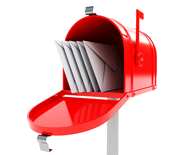 We’ve all heard someone say “print advertising is dead.” Or, “online marketing is the best way to market your business,” but we all know that is just not true. Don’t just take our word for it though, check out this article by Forbes to learn why direct mail is still the top channel for direct response. We know that as a business owner, you are inundated with sales calls from marketers telling you why their products and services are different from and better than your current advertising. We also know that with all the conflicting information out there, it can make it difficult to decipher what truly makes one marketing service different from another. So, to help clear up any confusion, we would like to remind our clients what truly makes Valpak different from the other direct marketers. Street-Level Mapping: A Powerful Marketing Advantage For Your Business Unlike other direct marketing companies who mail saturation lists (every address within a carrier route) or use a 3rd party in a distant location to determine their mailing list, we use our years of local knowledge to select our audience. Our Street-Level mapping program is integrated with Google Street View, allowing us to include or exclude specific addresses based upon our local knowledge and research. Through the years, our constantly evolving list has developed into a powerful marketing advantage for our clients. You can be certain — and the results show — our list delivers Valpak clients’ messages to the best audience of local consumers. If you are interested in learning more, ask your Valpak Marketing Advisor for additional information. Or better yet, schedule a visit to our office. We’d love to show you the process in person. Local Advertising: Over $150,000/Year in Northern Colorado Advertising We know advertising works, that’s why we practice what we preach and promote our Valpak Blue Envelope! You’ve seen our billboards. You’ve seen our blimp at the Colorado Eagles, our newspaper ads, and heard our radio spots. The consumers in northern Colorado have too, and that’s why they open Valpak and use your coupons! What do other direct marketing companies do to promote your advertising? Instant Win Program: Drives Opens Each month we randomly places $100 checks in our envelopes to encourage consumers to look through them every month, and the majority of them get cashed! Imagine the word-of-mouth exposure this creates among neighbors and the office! Who else has an instant win promotion? Content: Ensures a Positive Consumer Experience Valpak understands that content is key to drive envelope opens. We make sure there is a strong mix of categories that consumers want to see each month: dining, entertainment, retail, and home improvement categories. Valpak.com Listings: Get Found Online While our competitors may also list your offers online, Valpak provides you with your own unique URL on Valpak.com that is indexed on Google and other search engines. That means consumers can find you more easily and that you do not share a page with competing businesses. Sleek Envelope Design: High-End Design for High-End Consumers Recently, Valpak tested envelope designs with consumer groups and the feedback was clear — people want to see a sleek, clean, and BLUE Valpak envelope. In January 2018, we started delivering our new envelope design to better align with high-end consumers’ expectations. Longevity: Most Recognized Direct Mail Program There Is
Valpak has been powering businesses for 50 years and our local franchise has been in operation since 1978. We credit our longevity to staying true to our mission: To be the most effective advertising medium at generating business for our clients. To engage consumers and motivate them to do business with our clients by delivering interesting content and compelling offers through the mail, online, and the phone. Valpak of N. Colorado & S. Wyoming welcomes the opportunity to track and compare how your Valpak ads stack up against your other advertising programs. Contact your Valpak Marketing Advisor today to learn how. Although it is still early on in 2018, the direct mail industry has already seen a significant increase in both postage and paper costs this year, which may have you asking, “What does that mean for my direct mail marketing?”
First, let’s start with the facts. On January 21, 2018, the United States Postal Service increased postage. The saturation letters class in which Valpak falls increased by 1.94%, which you can read more about here. In addition to a postage increase, our industry has also seen a notable increase in paper costs, with companies experiencing an 8-10% increase in paper expense! So what does that mean for your direct mail marketing with Valpak? Not much! As an advertiser in our our co-op envelope, you split the cost of these increases with the other advertisers in the pack. So unlike other forms of direct mail, these industry changes will have a proportionally small impact on your direct mail rate. Want more good news? Direct mail continues to be a trusted and cost-effective form of advertising for small business owners. In fact, according the Direct Marketing Association (DMA), direct mail saw a 5.1% response rate in 2017, which is 10-30 times higher than that of digital advertising mediums! On behalf of Valpak of N. Colorado & S. Wyoming, we thank you for your business and look forward to continuing to serve your advertising needs. If you have any further questions about how these increases affect your business, please contact your Valpak Marketing Advisor. Guest Post
If you’ve ever considered starting your dream business, you’re not alone. Michael Gerber, the author of The E-Myth Revisited, called it the “entrepreneurial seizure.” I have to admit, I’ve experienced it a time or two as a business owner and actually grew up in what I call a “small business family,” working in my father’s business as a teenager. In fact, I learned how to work mowing the lawn at home and sweeping the floors of my Dad’s warehouse. He was adamant that I learn a good work ethic, making sure that I understood the right way to both mow and sweep. I didn’t appreciate at the time that there was a right way and a wrong way to do either—those lessons are more meaningful to me now than I think they were then. Having experienced the act of starting a business from scratch myself, I can share a few lessons I learned along the way. Taking the entrepreneurial leap should be a decision based on rational analysis rather than hope. As much as possible, grasp the sacrifices you may have to make so you can determine if the risk is worth the reward. Fortunately, in a study conducted not too long ago, 90 percent of the business owners said they would do it again and never look back. Before you entertain the idea of beginning your own entrepreneurship, here are some points to consider:
I met an inventor who had broken his arm. To ease the discomfort from itching, he drilled a hole in his cast so he could blow cool air into it with a hairdryer. He decided to make an adapter that could be placed in a cast by a doctor. Although it only cost him about $.30 to make, he charged $25. “Because,” he said, “doctors won’t buy it if it’s too cheap.” I learned that you can price things too low as well as too high and make it more difficult to sell your product.
Participate in your community events by volunteering, setting up at street fairs, holding a fundraising event. Participate in Small Business Saturday® and Shop Small®. Or, start small and simple with your marketing by sending a direct mail piece that offers a new customer discount. Valpak offers their Blue Envelope full of local business coupons that households anticipate receiving. Invite your community to a grand opening or holiday event with a postcard. In the very beginning, when my business was very small and we didn’t have a budget for the large direct mail campaign we wanted, my partners and I created our own postcards, addressed and stamped them after work on Monday, and deliver them to the post office. For somewhere around $100 every week we were able to send out postcards to customers and prospects to remind them we were there and introduce our weekly special. Like clockwork, the phones started ringing on Wednesday as our postcard arrived in their mailbox. Eventually, we had the budget for the large-scale direct mail campaign. Marketing doesn’t have to be expensive, but you have to do it. Be creative. Don’t be afraid to try something new. And, don’t be afraid to tackle something yourself. I think one of the things that made our postcard so successful was that it didn’t look slick and overproduced. It looked like exactly what it was, something we were doing ourselves. There’s nothing easy about starting your own business. It takes hard work, determination, commitment, vision, and sacrifice, but it’s also very rewarding. Doing your research and knowing what to expect will help you decide if business ownership is right for you. If it is, get out there and make your dream a reality. If you’ve decided that business ownership is something you want to make a reality, or you’re already there, Valpak is here to help you grow. With over 145 franchise offices across the United States and Canada, there’s a Valpak marketing expert near you. Download our Media Kit* and contact us today! Ty Kiisel is a contributing author focusing on small business financing at OnDeck, a technology company solving small business’s biggest challenge: access to capital. With over 25 years of experience in the trenches of small business, Ty shares personal experiences and valuable tips to help small business owners become more financially responsible. OnDeck can also be found on Facebook and Twitter. |
|
Valpak® of N. Colorado & S. Wyoming
1300 Oakridge Drive, Unit 130 Fort Collins, Colorado 80525 970-223-6245 |
Website by Canopy Creative Marketing. Copyright © 2022. Valpak of Northern Colorado and Southern Wyoming . All Rights Reserved.

